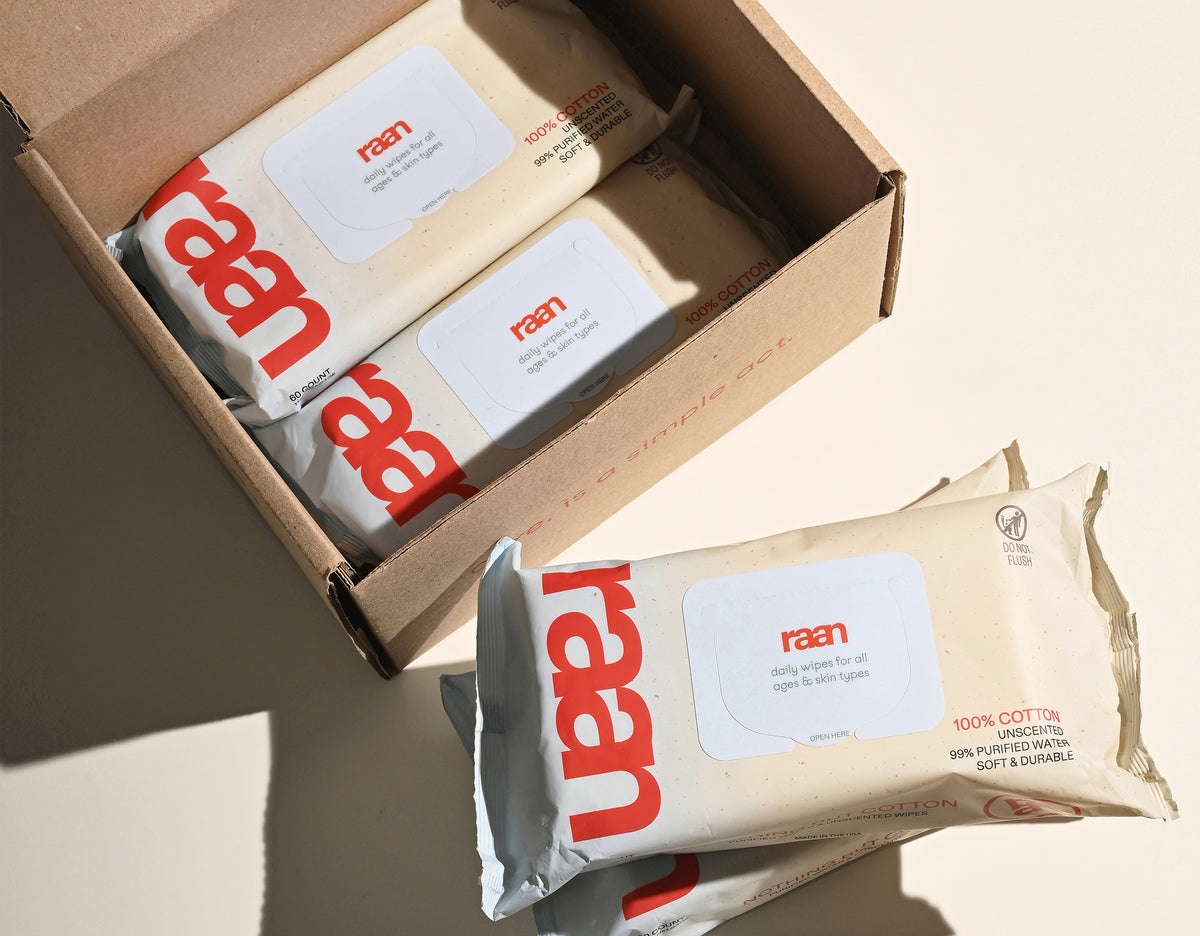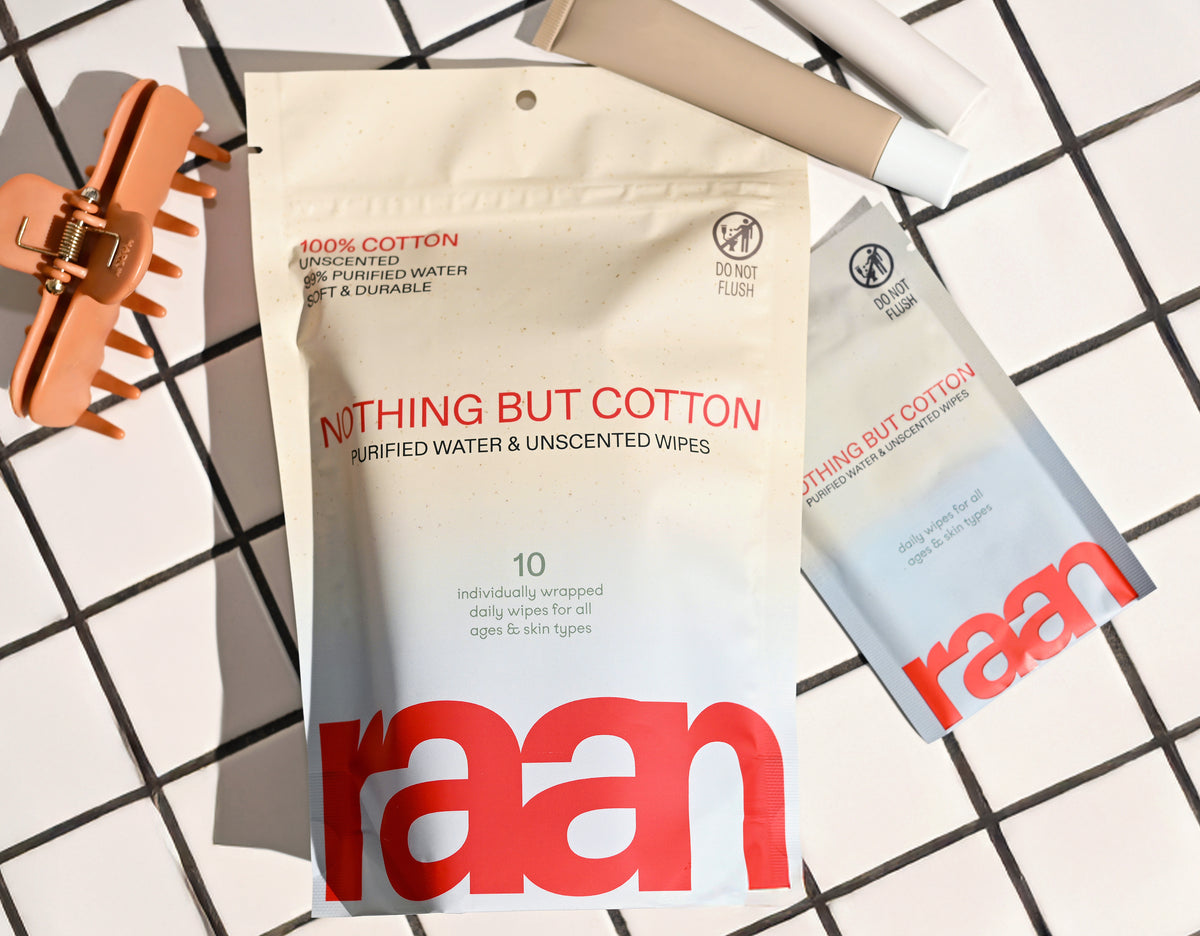Key Takeaways
- Unbleached, 100% cotton wipes are made from plant-based materials and contain minimal, food-grade ingredients.
- They use unbleached, 100% cotton instead of synthetic fibers or bleached pulp.
- Truly clean wipes have simple formulas with mostly water, organic aloe, and safe, food-grade preservatives.
- Conventional wipes often contain harsh preservatives and chemical additives that unbleached, 100% cotton wipes avoid.
- The quality of wipes depends on both the material and the formula used.
Table of Contents
- What Are Organic Wipes, And Why Are People Switching?
- Organic vs. Conventional Wipes, What's the Difference?
- Ingredient Integrity, How to Decode Labels and Spot Clean Claims
- Do Organic Wipes Work for All Skin Types, and Ages?
- Certifications and Sourcing, How to Find the Real Thing
- Real-Life Applications, Tips to Get the Most from Organic Wipes
- Sustainability Beyond Ingredients, Packaging and Environmental Impact
- The Raan Difference, Why Full Transparency Is Non-Negotiable
- Guidance and Next Steps, What to Try, How to Choose
What Are Organic Wipes, And Why Are People Switching?
The term "organic wipes" gets thrown around loosely, but here's what actually matters: the material and formula. True clean wipes start with unbleached, 100% cotton, not plastic fibers or bleached pulp, and contain only essential ingredients you can pronounce. Think 99% water, organic aloe, and food-grade preservatives instead of a 20-ingredient mystery list.
People are switching because conventional wipes often contain synthetic fragrances, parabens, and plastic fibers that can irritate sensitive skin. New moms discover this quickly when diaper rashes persist, or skincare lovers notice breakouts after using "gentle" face wipes. The EWG database shows that common wipe ingredients like phenoxyethanol and synthetic fragrances rank as moderate to high concern for skin allergies. For on-the-go needs, individually wrapped cotton face wipes offer a convenient and gentle solution.
Real clean wipes deliver what busy parents and conscious consumers actually need: effective cleaning without the guesswork. When your formula contains just five EWG-verified ingredients and unbleached, 100% cotton, there's no mystery about what's touching your skin, or your baby's. For more insights on choosing the right wipes for your family, you can read this guide on organic baby wipes.
What Counts as Clean and Safe
- Material: 100% natural cotton, unbleached and plastic-free
- Formula: Minimal ingredients, all with clear safety profiles
- Certifications: Third-party verified (EWG, Natural Cotton Seal)
- Transparency: Full ingredient disclosure with function explanations
Organic vs. Conventional Wipes, What's the Difference?

The gap between unbleached, 100% cotton wipes and conventional wipes comes down to four critical factors: materials, ingredients, safety testing, and environmental impact. Most conventional wipes use plastic-blend fabrics or bleached pulp that can leave microfibers on skin, while options like Raan use unbleached, 100% cotton that's naturally soft and biodegradable.
| Feature | Unbleached, 100% Cotton (Raan) | Conventional |
|---|---|---|
| Fiber Material | 100% unbleached cotton | Plastic, rayon, bleached pulp |
| Ingredient Count | 5 EWG-verified ingredients | 10-20+ synthetic additives |
| Preservatives | Food-grade (sodium benzoate, potassium sorbate) | Parabens, phenoxyethanol |
| Certifications | EWG Verified, Natural Cotton | Marketing claims only |
| Packaging Impact | 70% less plastic, 35% post-consumer waste | Hard plastic tubs, excess waste |
The results speak for themselves. Sensitive Skin Sara switched to unbleached, 100% cotton wipes after conventional ones triggered contact dermatitis around her daughter's diaper area. Within days of using unbleached cotton wipes with minimal ingredients, the irritation cleared. The difference wasn't just gentleness, it was predictable safety from ingredients she could research and trust. If you're looking for a convenient bundle, check out the mess-ready pack for all your cleaning needs.
Ingredient Integrity, How to Decode Labels and Spot Clean Claims
Reading wipe labels requires detective skills because brands hide problematic ingredients behind scientific names or simply don't list everything. Start with the material: if it doesn't specify "100% cotton" or "100% natural fiber," it likely contains plastic. Next, count the ingredients, anything over 10 suggests unnecessary additives.
Vague claims like "natural" and "gentle" mean nothing without ingredient transparency. Truly clean wipes list every component with its purpose: purified water (cleanser), organic aloe (moisturizer), sodium benzoate (food-grade preservative). Compare this to conventional wipes that might list "fragrance" (which can contain hundreds of unlisted chemicals) or "cleansing agents" without specifics.
Top 5 Red-Flag Ingredients to Avoid
- Synthetic fragrance: Can contain phthalates and allergens
- Phenoxyethanol: Preservative linked to skin irritation
- Parabens: Hormone-disrupting preservatives
- Polypropylene/polyester: Plastic fibers that don't biodegrade
- Chlorine bleach: Creates dioxin byproducts during manufacturing
Busy-but-Intentional Bri learned this the hard way after grabbing "organic" wipes that still contained synthetic preservatives and plastic fibers. Now she cross-references ingredients with the EWG Skin Deep database, a 30-second check that reveals safety ratings for every component. Real transparency means understanding what goes into your wipes. For more tips on choosing the best options, see this article on best wipes.
Do Organic Wipes Work for All Skin Types, and Ages?
Minimal formulas benefit everyone from newborns to adults precisely because they avoid common irritants. The 99% water base with organic aloe provides gentle cleansing without stripping natural oils, while food-grade preservatives maintain safety without harsh chemicals.
For newborns, the unbleached cotton material eliminates exposure to chlorine processing chemicals that can trigger reactions on developing skin. Adults benefit during hormonal changes, post-workout cleansing, or quick makeup touch-ups when conventional wipes might cause stinging or dryness. If you need a starter bundle for the whole family, the starter set is a great way to try different options.
Dermatologists note that simplified formulas reduce the likelihood of contact dermatitis because fewer ingredients mean fewer potential allergens. Frankie discovered this when she started using the same unbleached, 100% cotton wipes for both her newborn and her own postpartum skin changes, one product that addressed multiple needs without irritation. For more on facial cleansing, read about face wipes and their benefits for sensitive skin.
Certifications and Sourcing, How to Find the Real Thing

EWG Verified means every ingredient meets the Environmental Working Group's strictest safety standards, no exceptions or compromises. Natural Cotton Seal certifies the fiber source and processing methods, while Women Owned and Cruelty Free verify ethical business practices.
Verify authenticity by checking for certification logos directly on packaging, not just marketing materials. Real certifications include tracking numbers or verification codes you can cross-reference on the certifying organization's website. Unbleached, 100% cotton delivers superior absorbency and softness compared to "organic" products with undisclosed fiber sources.
Real-Life Applications, Tips to Get the Most from Organic Wipes
Store wipes with the pouch opening facing down to maintain moisture distribution. Seal immediately after each use and consume within two months of opening for optimal freshness. One wipe handles most adult cleansing needs; two wipes work for thorough diaper changes.
Multi-Purpose Applications
- Post-Workout Refresh: Face and hands cleansing without gym sink concerns
- Diaper Changes: Gentle enough for rash-prone skin, effective for thorough cleaning
- Makeup Touch-Ups: Removes excess product without disturbing base application
- Travel Cleansing: TSA-friendly alternative when water access is limited
If wipes dry out, add 2-3 drops of distilled water to the pouch, seal for 10 minutes, then redistribute moisture by gently massaging the package. This restores usability without compromising the formula's safety. For more on how long wipes stay fresh, see this guide on how long wipes last.
Sustainability Beyond Ingredients, Packaging and Environmental Impact
Our packaging uses 70% less plastic than conventional wipes by eliminating hard plastic lids. The pouch contains 35% post-consumer waste, and boxes are 100% recyclable through standard municipal programs.
| Packaging Element | Raan Unbleached Cotton | Industry Standard |
|---|---|---|
| Plastic Content | 70% reduction | Hard plastic lids + excess wrapping |
| Recycled Materials | 35% post-consumer waste | Minimal recycled content |
| Disposal Method | Wipes: landfill, Box: recycle | Mixed waste stream |
The unbleached cotton material biodegrades faster than synthetic fibers, though wipes should never be flushed. Dispose of used wipes in regular waste; compost packaging materials where facilities accept them. For more on environmental impact, see this peer-reviewed study on biodegradable materials.
The Raan Difference, Why Full Transparency Is Non-Negotiable

Five EWG-verified ingredients, unbleached, 100% cotton, and complete supply chain visibility, no exceptions. We preserve natural material benefits without over-engineering, delivering consistent performance for everyday messes and sensitive skin needs.
Recognition from the 2025 National Parenting Product Awards and Baby Innovation Award validates our commitment to authentic safety over marketing claims. The unbleached cotton feels noticeably softer and more absorbent than processed alternatives, maintaining strength when wet without synthetic reinforcement. For more on cosmetic ingredient regulations, visit the FDA's official guidance.
Guidance and Next Steps, What to Try, How to Choose
Match your priorities to product features: new parents need proven gentle formulas, busy professionals want reliable grab-and-go options, and eco-conscious users require verified sustainable practices. Unbleached, 100% cotton wipes address all these needs through simplified, transparent formulations.
- Fiber material clearly stated (100% cotton preferred)
- Complete ingredient list with functions explained
- Third-party safety certifications visible
- Packaging sustainability details provided
- Company supply chain transparency available
Start with sample sizes to test skin compatibility, then consider subscription options for consistent supply. The switch to cleaner care doesn't require compromise on effectiveness, just commitment to transparency over marketing illusions.
Frequently Asked Questions
What are the main differences between unbleached, 100% cotton wipes and conventional wipes?
Unbleached, 100% cotton wipes use natural plant-based fibers without bleaching or plastic, while conventional wipes often rely on synthetic fibers and bleached pulp. The formula in cotton wipes is minimal and food-grade, avoiding harsh preservatives and chemical additives common in conventional options.
Why are unbleached, 100% cotton wipes considered safer and better for sensitive skin?
Because they contain simple, EWG-verified ingredients like purified water and organic aloe, unbleached cotton wipes avoid synthetic fragrances, parabens, and alcohol-based irritants that can cause skin reactions. Their natural fibers and gentle formula make them a reliable choice for sensitive skin and everyday messes.
How can I identify truly clean and organic wipes when shopping?
Look for wipes made from unbleached, 100% natural cotton with a short, transparent ingredient list featuring mostly water and food-grade preservatives. Certifications like EWG Verified and Natural Cotton Seal help confirm integrity, while clear labeling about what’s not included, no plastic fibers, no harsh chemicals, signals real transparency.
What environmental benefits do unbleached, 100% cotton wipes offer compared to conventional options?
Unbleached cotton wipes use biodegradable fibers without plastic, reducing microplastic pollution. Their minimal processing avoids chemical bleaching, and packaging with less plastic and recycled materials lowers waste, making them a more sustainable choice for everyday care.






